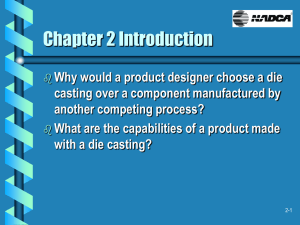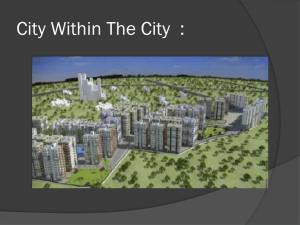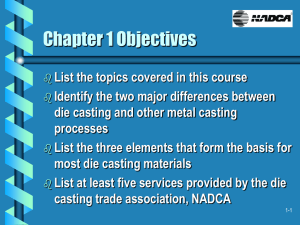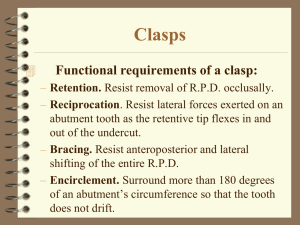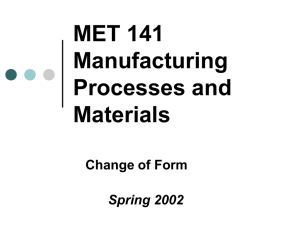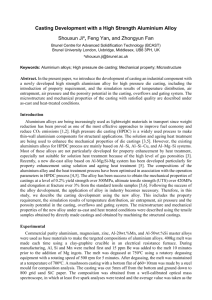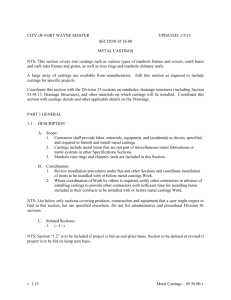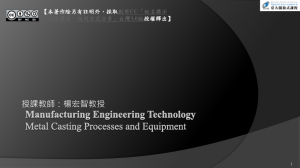Design Considerations in Casting
advertisement
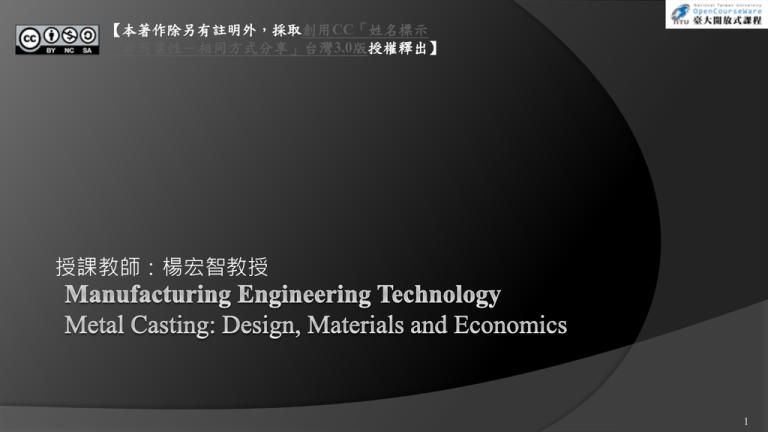
【本著作除另有註明外,採取創用CC「姓名標示 -非商業性-相同方式分享」台灣3.0版授權釋出】 授課教師:楊宏智教授 1 楊宏智(台大機械系教授) 2 Chapter Outline Introduction 2. Design Considerations in Casting 3. Economics of Casting 1. Introduction Successful casting practice requires proper control of a large number of variables Flow of the molten metal in the mold cavities, the gating systems, the rate of cooling, and the gases evolved would influence the quality of a casting Design Considerations in Casting All casting operations share the characteristics of phase change and thermal shrinkage during the casting cycle But each process will have its own design considerations Sand casting will require mold erosion and sand inclusions in the casting Die casting will not have this concern Defects frequently are random and difficult to reproduce Design Considerations in Casting: General Design Considerations for Castings 2 types of design issues in casting: 1. Geometric features and tolerances incorporated into the part 2. Mold features that are needed to produce the desired casting Design Considerations in Casting: General Design Considerations for Castings Design of Cast Parts Corners, angles, and section thickness Flat areas Shrinkage Draft Dimensional tolerances Lettering and markings Finishing operations Design Considerations in Casting: General Design Considerations for Castings Locating the Parting Line Parting line is the line or plane separating the upper (cope) and lower (drag) halves of molds Parting line should be along a flat plane rather than be contoured Location is important as it influences mold design, ease of molding, number and shape of cores required, method of support and the gating system Parting line should be low for less dense metals and located at mid-height for denser metals Design Considerations in Casting: General Design Considerations for Castings Locating and Designing Gates Multiple gates are preferable Gates should feed into thick sections of castings A fillet should be used Gate closest to the sprue should be placed sufficiently far away from the sprue Minimum gate length should be 3 to 5 times the gate diameter Curved gates should be avoided Design Considerations in Casting: General Design Considerations for Castings Runner Design Runner is a horizontal distribution channel that accepts molten metal from the sprue and delivers it to the gates It is used to trap dross and keep it from entering the gates and mold cavity Designing Other Mold Features Goal in designing a sprue is to achieve the required metal flow rates while preventing excessive dross formation Design Considerations in Casting: General Design Considerations for Castings Designing Other Mold Features Goal in designing a sprue is to achieve the required metal flow rates while preventing excessive dross formation Turbulent flow rates should be avoided A pouring basin is used to ensure uninterrupted metal flow into the sprue Filters are used to trap large contaminants and more laminar flow Chills used to speed up solidification of the metal Design Considerations in Casting: General Design Considerations for Castings Establishing Good Practices High-quality molten metal is essential for producing superior castings Pouring of metal should not be interrupted Stress relieving necessary to avoid distortions of castings in critical applications Design Considerations in Casting: General Design Considerations for Castings 1. 2. 3. Expendable-mold process cool much slower than die casting Important design considerations are: Mold Layout - must be placed logically and compactly with gates Riser Design - consideration in size and placement of risers Machining Allowance - require for additional finishing operations Design Considerations in Casting: Design for Permanent-mold Casting Designs may be modified to eliminate the draft for better dimensional accuracy Die-cast parts are net shaped to remove gates and minor trimming to remove flashing and defects They do not require a machining allowance Design Considerations in Casting: Computer Modeling of Casting Processes Casting involves complex interactions among material and process variables A quantitative study of these interactions is essential to the proper design and production of high-quality castings Studies consist of heat flow, temperature gradients, nucleation and growth of crystals, formation of dendritic and equiaxed structures, impingement of grains and movement of the liquid– solid interface during solidification Commercial software programs are Magmasoft, ProCast, Solidia and AFSsolid Economics of Casting Cost of each cast part (unit cost) depends on several factors, including materials, equipment, and labor Each of individual factors affects the overall cost of a casting operation Economics of Casting Costs are involved in melting and pouring the molten metal into molds and in heat treating, cleaning, and inspecting the castings Labor and skills required is also a consideration Equipment cost per casting will decrease as the number of parts cast increases High production rate can justify the high cost of dies and machinery

